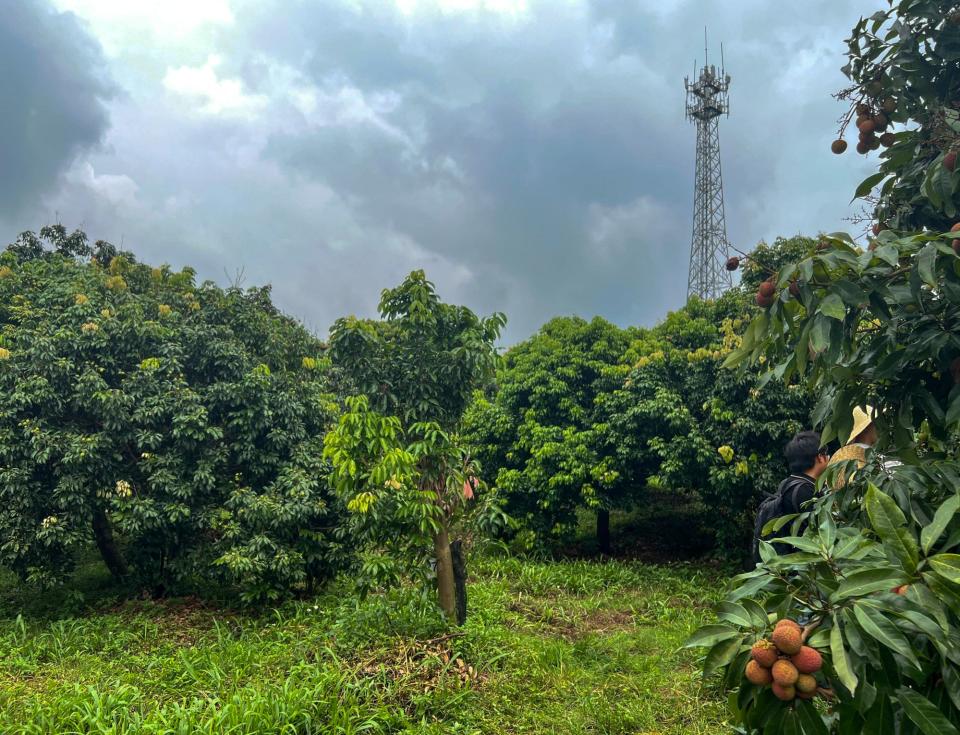In the heart of an 11-acre lychee orchard, Yin Yaocheng begins his daily labour early in the morning. But unlike some of his fellow farmers, who spend the day ploughing fields or harvesting fruit, Yin films himself taking leisurely strolls among lush trees while talking into a smartphone.
Yin, the marketing head of Donglin Fruit Farm in the Zengcheng district of Guangzhou, capital of southern Guangdong province, has been live streaming since 2022 as a way to sell produce and draw visitors to its pick-your-own fruit operation, with the help of improving 5G mobile technology that enables smoother interaction with his audience.
“Live streaming has helped us achieve business growth of 20 to 30 per cent annually since we started in 2022,” Yin told a group of reporters at the Zengcheng Lychee Live Streaming on Thursday, where a 5.5G network was being tested in a rural live-streamed broadcast for the first time. The service was powered by Huawei Technologies and China Unicom.
Do you have questions about the biggest topics and trends from around the world? Get the answers with SCMP Knowledge, our new platform of curated content with explainers, FAQs, analyses and infographics brought to you by our award-winning team.
5.5G, which Huawei calls 5G-Advanced, is expected to bring a tenfold improvement in network performance over 5G, with peak downlink speed climbing from 1 gigabit per second to 10Gbps, and peak uplink speed rising from 100 megabits per second to 1Gbps.

The 5G cell tower enables smooth live streams in this lychee farm in the Zengcheng district of Guangzhou, capital of southern Guangdong province. Photo: Iris Deng alt=The 5G cell tower enables smooth live streams in this lychee farm in the Zengcheng district of Guangzhou, capital of southern Guangdong province. Photo: Iris Deng>
“The commercialisation of 5G-Advanced will support the creation of an ‘information highway’ that’s ubiquitous and fast, providing the infrastructure for an intelligent era,” said Hou Yingzhen, president of 5G marketing and solution sales at Huawei.
China Unicom, one of China’s big three telecommunications network operators, has offered farmers a 5G service package tailored for live-streaming users that gives subscribers priority in uplink speed and traffic through so-called 5G-slicing technology.
Yin said the enhanced 5G coverage has allowed him to live stream in wider areas of the farm with better video quality. In the past, he had to stick to one spot where the signal was the strongest.
“A leaf only moves when the wind touches it, and a flower becomes more vibrant when the sun shines on it,” Yin said. “With the technology, we can better showcase these details to our viewers through live streams, and ultimately boost sales conversion.”


Live streamers promote locally grown lychees to a vast online audience. Photo: Handout alt=Live streamers promote locally grown lychees to a vast online audience. Photo: Handout>
Live streaming e-commerce has increasingly become a popular channel for Chinese fruit farmers to boost sales, especially for seasonal produce with a short growing season. However, supporting 5G infrastructure in the countryside comes with some unique challenges.
Building 5G networks in rural areas entails higher costs, as pieces of infrastructure are spaced further apart compared to those in cities, according to Wang Liang, deputy general manager of production innovation at China Unicom’s Guangdong branch. It is also more difficult to generate investment returns in less populous areas, he said.
Still, China has made a strong push in recent years to upgrade digital infrastructure in rural areas, an effort that has motivated enterprises to invest in and deploy connected devices to boost production and sales in agriculture, Wang added.
Guangdong had over 326,000 5G base stations as of the end of 2023, covering nearly all prefecture, county and town-level urban areas, as well as 94.5 per cent of village-level divisions, according to official data. This year, the province plans to add 38,000 stations and 18 million users.


Lychee farmers in the Zengcheng district of Guangzhou, capital of southern Guangdong province, are bracing for a lean year, owing to a warm winter and heavy rain in the spring. Photo: Handout alt=Lychee farmers in the Zengcheng district of Guangzhou, capital of southern Guangdong province, are bracing for a lean year, owing to a warm winter and heavy rain in the spring. Photo: Handout>
Zengcheng has invested around 10 million yuan (US$1.4 million) annually in the past four to five years to upgrade its 5G network and other digital infrastructure, according to Tan Yushan, section chief of market information and science and education at the district’s agricultural and rural bureau.
But mobile internet coverage is just one of many challenges facing lychee farmers in Zengcheng. A warmer winter and heavy rain in spring are expected to reduce production by 40 per cent this year, Tan said.
Yin, the farmer, is concerned that the shortage will drive up lychee prices by so much that consumers are no longer willing to buy them – even with the help of live streaming.
“Some premium varieties may see their prices more than double this year, which makes it harder to sell,” he said.
This article originally appeared in the South China Morning Post (SCMP), the most authoritative voice reporting on China and Asia for more than a century. For more SCMP stories, please explore the SCMP app or visit the SCMP’s Facebook and Twitter pages. Copyright © 2024 South China Morning Post Publishers Ltd. All rights reserved.
Copyright (c) 2024. South China Morning Post Publishers Ltd. All rights reserved.
Source Agencies

